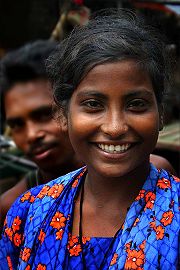
Women in Bangladesh
Encyclopedia


Bangladesh
Bangladesh , officially the People's Republic of Bangladesh is a sovereign state located in South Asia. It is bordered by India on all sides except for a small border with Burma to the far southeast and by the Bay of Bengal to the south...
remained considerably inferior to that of men. Women, in custom and practice, remained subordinate to men in almost all aspects of their lives; greater autonomy was the privilege of the rich or the necessity of the very poor. Most women's lives remained centered on their traditional roles, and they had limited access to markets, productive services, education, health care, and local government. This lack of opportunities contributed to high fertility patterns, which diminished family well-being, contributed to the malnourishment and generally poor health of children, and frustrated educational and other national development goals. In fact, acute poverty at the margin appeared to be hitting hardest at women. As long as women's access to health care, education, and training remained limited, prospects for improved productivity among the female population remained poor.
About 82 percent of women lived in rural areas in the late 1980s. The majority of rural women, perhaps 70 percent, were in small cultivator, tenant, and landless households; many worked as laborers part time or seasonally, usually in post-harvest activities, and received payment in kind or in meager cash wages. Another 20 percent, mostly in poor landless households, depended on casual labor, gleaning, begging, and other irregular sources of income; typically, their income was essential to household survival. The remaining 10 percent of women were in households mainly in the professional, trading, or large-scale landowning categories, and they usually did not work outside the home.
The economic contribution of women was substantial but largely unacknowledged. Women in rural areas were responsible for most of the post-harvest work, which was done in the chula
Kitchen
A kitchen is a room or part of a room used for cooking and food preparation.In the West, a modern residential kitchen is typically equipped with a stove, a sink with hot and cold running water, a refrigerator and kitchen cabinets arranged according to a modular design. Many households have a...
, and for keeping livestock, poultry, and small gardens. Women in cities relied on domestic and traditional jobs, but in the 1980s they increasingly worked in manufacturing jobs, especially in the readymade garment industry. Those with more education worked in government, health care, and teaching, but their numbers remained very small. Continuing high rates of population growth and the declining availability of work based in the chula meant that more women sought employment outside the home. Accordingly, the female labor force participation rate doubled between 1974 and 1984, when it reached nearly 8 percent. Female wage rates in the 1980s were low, typically ranging between 20 and 30 percent of male wage rates.

